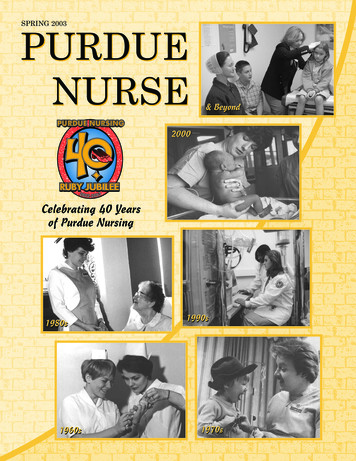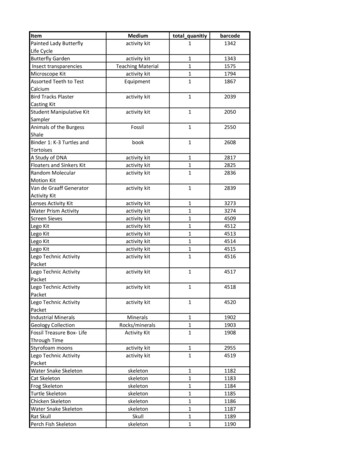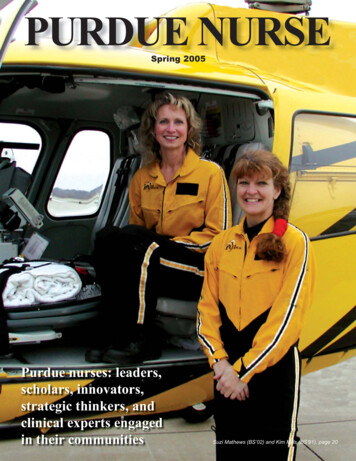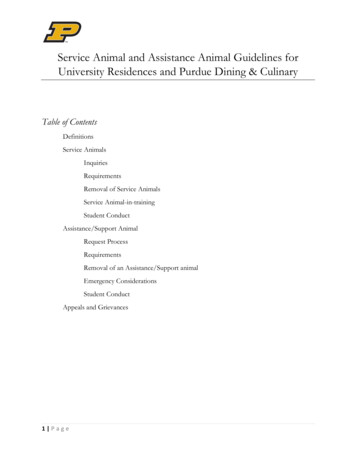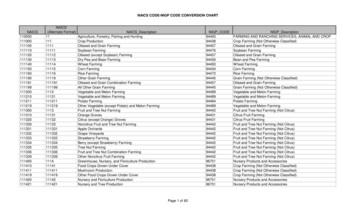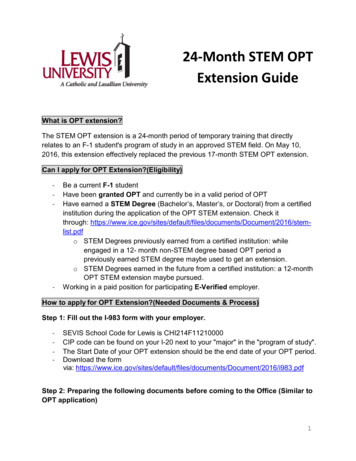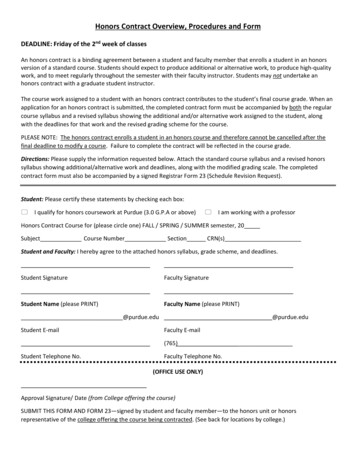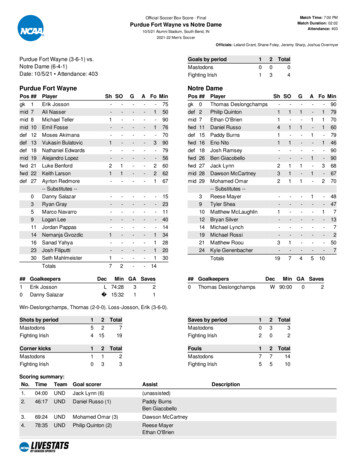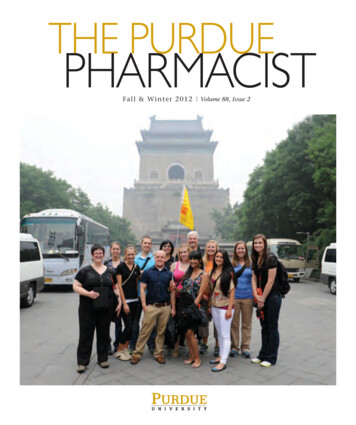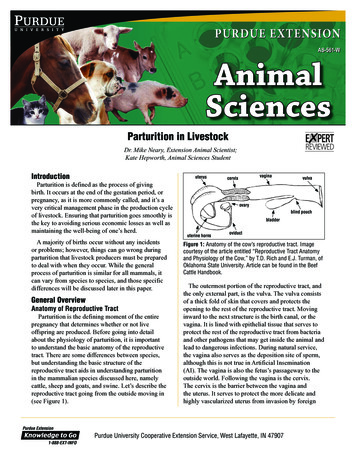
Transcription
Purdue ExtensionAS-561-WAnimalSciencesParturition in LivestockDr. Mike Neary, Extension Animal Scientist;Kate Hepworth, Animal Sciences StudentIntroductionuterusParturition is defined as the process of givingbirth. It occurs at the end of the gestation period, orpregnancy, as it is more commonly called, and it’s avery critical management phase in the production cycleof livestock. Ensuring that parturition goes smoothly isthe key to avoiding serious economic losses as well asmaintaining the well-being of one’s herd.A majority of births occur without any incidentsor problems; however, things can go wrong duringparturition that livestock producers must be preparedto deal with when they occur. While the generalprocess of parturition is similar for all mammals, itcan vary from species to species, and those specificdifferences will be discussed later in this paper.General OverviewAnatomy of Reproductive TractParturition is the defining moment of the entirepregnancy that determines whether or not liveoffspring are produced. Before going into detailabout the physiology of parturition, it is importantto understand the basic anatomy of the reproductivetract. There are some differences between species,but understanding the basic structure of thereproductive tract aids in understanding parturitionin the mammalian species discussed here, namelycattle, sheep and goats, and swine. Let’s describe thereproductive tract going from the outside moving in(see Figure 1).vaginacervixvulvaovaryblind pouchbladderuterine hornsoviductFigure 1: Anatomy of the cow’s reproductive tract. Imagecourtesy of the article entitled “Reproductive Tract Anatomyand Physiology of the Cow,” by T.D. Rich and E.J. Turman, ofOklahoma State University. Article can be found in the BeefCattle Handbook.The outermost portion of the reproductive tract, andthe only external part, is the vulva. The vulva consistsof a thick fold of skin that covers and protects theopening to the rest of the reproductive tract. Movinginward to the next structure is the birth canal, or thevagina. It is lined with epithelial tissue that serves toprotect the rest of the reproductive tract from bacteriaand other pathogens that may get inside the animal andlead to dangerous infections. During natural service,the vagina also serves as the deposition site of sperm,although this is not true in Artificial Insemination(AI). The vagina is also the fetus’s passageway to theoutside world. Following the vagina is the cervix.The cervix is the barrier between the vagina andthe uterus. It serves to protect the more delicate andhighly vascularized uterus from invasion by foreignPurdue University Cooperative Extension Service, West Lafayette, IN 47907
objects, and is also a tight seal that keeps the uterusclosed during pregnancy. The uterus is a structure thatconsists of a body and two horns in livestock species.While it is very small in an animal that is not pregnant,during pregnancy it expands enough to house thegrowing fetus (or feti) until ready to be expelled fromthe body. At the end of each one of the uterine hornsare the oviducts and the ovaries. The ovaries serve asthe production site for ova, or eggs; the oviducts arethe egg’s path between the ovaries and the uterus.Fertilization and PregnancyParturition is preceded by two very important events:fertilization and gestation (pregnancy). Fertilizationoccurs after sperm has entered the uterus and travelsthrough the reproductive tract until reaching theoviduct. When an egg is released from the ovary, ittravels into the oviduct where it can be penetrated,and thus fertilized by the sperm. The fertilized eggthen moves through the oviduct, the uterine horns,and finally, to the uterine body where it remains forthe duration of pregnancy. Once the egg reaches theuterine body, it implants into the endometrium (thelining of the uterus), where it grows and developsuntil parturition. The fetus develops and grows in theuterus, and is surrounded by membranes and fluidsknown as the amniotic sac and the placenta. When itis fully formed and ready to exit the mother’s body,it rotates in the uterus, and thus begins the process ofparturition.ParturitionIt is very important that during parturition the animalmoves smoothly through the three stages of parturitionin a reasonable amount of time to ensure a safe andnormal birth.The first stage of parturition is known as thePreparatory Stage. It is during this stage, as is evidentfrom the name, that the female prepares to give birth.Some signs that parturition is near can be observedduring this stage. These signs may differ slightlyamong species; but in general, the female becomesrestless and may be seen raising her tail and separatingherself from the herd. In addition, there may be mucusdischarge from the vulva, decreased body temperature,filling of mammary glands with milk, and mildstraining. Behavioral signs include nesting behaviorand possibly stealing other newborns in the herd.During the preparatory phase, the fetus rotates itselffrom the position that it has maintained throughoutpregnancy into the position required for parturition.Purdue Extension Knowledge to GoThis position varies somewhat between differentspecies, and the specific positions will be discussedlater. The cervix starts to dilate during this stage,and the first part of the fetus enters the birth canal.Fetal membranes may be visible as they protrude outthrough the vulva at this time.The second stage of parturition is the ExpulsionStage. It is at this point that the walls of the uterusbegin to contract more frequently and with increasedforce, thus pushing the fetus into the birth canal.When the contractions become strong enough, thefetus is actually forced out of the female’s body, hencethe name the Expulsion Stage. Once an animal hasentered this stage, delivery should occur fairly soon;otherwise, there may be difficulties preventing normaldelivery. Again, the standard amount of time allowedfor a normal birth can differ between species.The final stage of parturition is the Cleaning Stage.It is at this point in the process that the afterbirth,or the placenta, is expelled from the body. In orderfor the animal to make a normal, healthy recoveryfrom parturition, the afterbirth must be expelled. Ifthe fetal membranes and fluid remain in the animal,they can become infected and lead to serious illnessand possible death of the mother. Once the fetalmembranes have left the body, and the uterine lininghas been shed, the uterus can begin to contract backto the significantly smaller size that it maintains whenthe animal is not pregnant. The process by whichthe uterus shrinks back to its normal size is called“involution”.Specific Species and Common ProblemsCattleIn cattle, parturition is referred to as calving.Reproduction in cattle, as with other livestock, isof great importance. Large amounts of money andtime are invested in producing new, healthy calvesevery year. Dairy and beef cows experience the sameprocess as they go through pregnancy and parturition.Parturition occurs at the end of the gestation period,which lasts approximately 283 days. Heifers (youngcows that have not yet calved) and smaller cowsmay give birth about 10 days before the expectedparturition date, whereas older cows and largerbreeds may have a 10 day increase in their gestationperiod. The entire process of calving should lastapproximately 8-12 hours.Stage 1, where the cervix dilates and fetus rotatesto its birthing position and moves to the birth canal,
should last from two to six hours. This stage may lastlonger in heifers. Stage 2 can last from 30 minutes upto 4 hours. Stage 3 should have occurred within 8 to12 hours after the fetus is delivered. If any stage seemsto be taking an abnormally long time, there could bea serious problem, and the cow should be thoroughlyexamined to determine what is causing the delay.its front legs (see Figure 3). Any other presentation isconsidered malpresentation, and more than likely willlead to dystocia.Usually, calving moves smoothly and quickly,with no problem, but problems at calving are notuncommon. The individual caring for cows at calvingtime needs to be aware that problems may occur andshould know what to do. The most common problemat parturition is dystocia. Dystocia is the technical termthat describes any difficulty during parturition.In cattle, the most common cause of dystocia is acalf that is too large to fit through the birth canal andthe opening in the cow’s pelvis (see Figure 2). This istermed a fetal-dam disparity, and can be from a largecalf, a small cow or heifer, or both. If a cow appears toFigure 3: The normal birth position of a calf. Image courtesyof Dr. Larry Horstman, D.V.M., Purdue University School ofVeterinary Medicine.Assistance is required when a cow appears to behaving problems giving birth. If the calf is in thewrong position, it is possible for a person to examinethe cow and gently rearrange the calf so that is inthe correct position and can be delivered. If the calfappears to actually be stuck, it may take some moreeffort on the part of the person, but it is possible toassist and deliver a healthy, live calf.Figure 2: An example of “hip lock” in cattle. Note also thebreech calf. Photograph courtesy of Dr. Larry Horstman,D.V.M., Purdue University School of Veterinary Medicine.be straining for long periods of time, she may be tryingto deliver her calf, but it may be “stuck” in the openingin her pelvis. The calf may simply be too large for anormal birth. Sometimes the calf’s head, shoulders,and body may be in or through the pelvic opening, butits hips may be stuck, a condition known as hip-lock.Dystocia can also occur when the calf is inthe wrong position for parturition, this is calledmalpresentation. The proper position for a calf (as wellas sheep and goats) exiting the birth canal is facingforward with its back up and its head resting betweenPurdue Extension Knowledge to GoBefore assisting a cow, the cow’s vulva and thesurrounding area should be cleaned, as well as thehand and arm of the person who will be assisting thecow. Any other equipment that may be going insidethe animal should be disinfected and properly storedbetween uses. If bacteria gets inside the reproductivetract, infections may be deleterious to futurereproductive performance. When everything necessaryhas been disinfected, it is critical that large amountsof lubricant are used before anything enters the birthcanal. Products such as petroleum-based jellies or evensolid cooking compounds can be used as lubrication. Alack of lubrication can cause serious tissue damage tothe cow, which may endanger her reproductive abilityin the future. There is some indication that assistingwith parturition too early can interfere with the thirdstage of parturition.When all of the necessary precautions have beentaken, a long sleeve plastic glove should be worn tofurther protect the cow from bacteria. The hand andarm of the person can enter the birth canal through
the vulva and slowly find the calf. It is very importantthat the person assisting with the calving be able tovisualize what it is that they are feeling inside the cow.In a normal position, one would be able to feel thehead and both of the front legs and hoofs. Make surethat both of them extend back toward the rear of thecow. This would indicate that the calf is in the properposition. However, if this is not what the person feels,then further assistance is needed. Some of the morecommon malpresentations include a calf that has oneor both forelegs back, its head back (see Figure 4), orthe animal coming backward in breech position (seeFigure 5). A breech calf is completely backwards in theuterus, with the back legs tucked under the abdomenPulling a calf needs to be done very carefullyand gently. It is done best and most safely eitherwith obstetrical (pulling) chains, or a calf puller.When chains are to be used, they should be firstdisinfected and then looped around each leg of thecalf at least twice. The chains should be slid up thefront legs so that they are around the cannon bonesand are two to three inches above the ankles and dewclaws (see Figure 6) to protect the delicate tendonsin the pasterns. The best way to pull the calf is toalternatively pull on each leg and gradually and gently“walk” the calf out until the shoulders have gottenthrough the pelvis. Pulling should always be done in adownward arcing motion, toward the hocks of the cow.Figure 4: Malpresented calf with head back. Image courtesyof Dr. Larry Horstman, D.V.M., Purdue University School ofVeterinary Medicine.Figure 6: The proper way to attach pulling chains to a calf’sforeleg. Photograph courtesy of Dr. Larry Horstman, D.V.M.,Purdue University School of Veterinary Medicine.Figure 5: A breech calf in the uterus. Image courtesy ofDr. Larry Horstman, D.V.M., Purdue University School ofVeterinary Medicine.When calving assistance is necessary, there are afew methods that may aid in the eventual birth of thecattle. It may be possible in some cases, to push thecalf back, very gently, into the uterus where it canbe repositioned into normal position. In some cases,however, this may not be possible. The calf may stillnot come out easily. In the event that this happens, anexperienced herdsman or a veterinarian will need topull the calf.Purdue Extension Knowledge to GoAn alternative method to deliver a calf is through theuse of a calf puller or calf jack. This is an instrumentthat can effectively have the pulling force of sevenfull-grown men. These should be used only whennecessary, and should be used only by experiencedherdsmen or veterinarians. If calving is still notmoving smoothly, or other problems are encountered,a veterinarian should be contacted, as a Caesareansection may be necessary to get the calf out alive.Whatever the situation, ultimate care must be taken toavoid doing any harm to the cow. Pulling the calf cancause its hooves to scratch against the uterine tissue,causing dangerous rips and tears in the lining of theuterus or the vagina. Pulling too hard can also tear thecervix or the birth canal, further endangering the cow,not to mention harm the calf.Difficult calvings cause significant economic lossin the cattle industry each year. In order to combatthese losses, a system of calving-ease scoring hasbeen developed in order to allow producers to betterpredict which mating will result in a difficult birth.This system rates dams on a scale of 1 to 5, with 1
being the score of an unassisted birth, and 5 describingextremely difficult calving. Dams are scored after eachcalving, and the scores are compiled and reviewed todetermine the likelihood that a sire will cause a dam tohave difficulty giving birth. These scores are a usefultool for breeders because they allow them to see whichsires are more likely to cause difficult births, and theycan then choose to avoid those sires if desired. Thesecalving ease scores are most important in choosingmates for heifers that have not yet calved.Once the calf has been brought safely into theoutside world, there are still a few steps that need tobe taken to ensure that it survives. First and foremost,it is necessary that the calf begins to breathe. Ticklingthe inside of the calf’s nostril with either a piece of hayor straw will induce the calf to sneeze, thus clearingthe mucous from its airway and allowing it to beginbreathing by itself. The mucous also can be cleared bygently swinging the calf upside down by its hind legsfor a short period of time to allow the fluids to flowout of the lungs and airways and out of the body.The second step is to ensure that a newborn can ingestits mother’s first milk, the colostrum (see Figure 7).The colostrum contains important antibodies andnutrients to make the calf immune to many infectiousdisease, which can be transmitted to calves by bacteriaon teats. Finally, it is a safety precaution to disinfectthe calf’s umbilical region with tincture of iodine oranother disinfectant (such as a Nolvasan solution) toprevent any infection from entering the bloodstreamthrough the navel.After the calf is up and nursing (only beef calves areallowed to nurse), the process of parturition is nearlycomplete. The final stage is the cleaning stage, wherethe cow must expel the placenta, or afterbirth, fromher uterus so that the uterus can return to its normal,very small size in a process called involution. Keepingcows calm after delivery can aid in the response of theuterus to the hormone oxytocin that helps the uteruscontract and expel the fetal membranes. The cowshould be observed closely over the next 12 hours, orso, to make sure that the afterbirth has been expelled.If a cow fails to clean within 12 to 24 hours afterdelivery, a veterinarian should be contacted. A retainedplacenta can lead to very serious infections.Sheep and GoatsSheep and goats are very similar to cattle in theprocess that they go through when giving birth. Insheep, the process of parturition is called “lambing,”and it is referred to as “kidding” in goats. Thegestation period in sheep and goats are very similar,with sheep giving birth after 144-150 days, and goatskidding at around 150 days.When a ewe (female sheep) or a doe (female goat) isabout to give birth, there will be certain signs that mayindicate she is ready for parturition. Just as in cattle,the female will appear restless and uncomfortable.She may paw the ground, begin breathing heavier andfaster, or separate herself from the other females inthe herd. Her physical appearance may change, withkey indicators being the filling out of the udders andthe caving in of her sides. The mucus plug may beexpelled from her vulva, and the shepherd may noticethat the female’s water broke.Figure 7: A newborn calf up and milking shortly afterparturition. Photograph courtesy of NorwellMA.comdiseases that it is susceptible to in the early stages oflife. Dairy calves are not allowed to get colostrumdirectly from their mothers. They are instead given 2quarts of colostrum manually in their first hour of life.They should have at least 4 quarts by the time theyreach 6 hours of age. This is done with dairy calvesin order to ensure that they get an adequate amount ofcolostrum, and also to protect the calf from Johne’sPurdue Extension Knowledge to GoOnce it is evident that a doe or ewe is about to givebirth, it is extremely important that she be observedclosely to make sure that the process of parturitionmoves smoothly (see Figure 8). The stages ofparturition are the same in sheep or goats as they arein cattle; however, they are shortened significantlyin duration. After the obvious signs of impendingparturition have been observed, the female should bewatched closely to see when her water breaks. Afterthe water breaks, labor should begin smoothly andprogress without complications.
Figure 10: A malpresentation of a lamb, with its head back.Image courtesy of Dr. Nolan Hartwig, D.V.M., Iowa StateUniversity.Figure 8: Sequence of a ewe giving birth. Photographcourtesy of the Purdue Sheep Page.The normal birth position in lambs and kids is justas it is in cattle, with the head resting between theforelegs (see Figure 9). The most common cause ofdystocia in sheep and goats is malpresentation of thefetus or feti. As mentioned previously, the normalpresentation of the fetus is with the head restingbetween the forelegs. Common malpresentationsFigure 11: A lamb in breech presentation. Image courtesy ofDr. Nolan Hartwig, D.V.M., Iowa State University.Figure 9: Normal presentation of a lamb in utero. Imagecourtesy of Dr. Nolan Hartwig, D.V.M., Iowa State University.include lambs or kids that have their head turnedbackwards (see Figure 10) and breech presentation inthe uterus (see Figure 11), where they are completelybackwards. They can also have one or both of the frontlegs back, the hind legs coming first, or four feet atonce. It is common for a ewe or doe to have multiplelambs or kids, and in this event, it is possible thattwo lambs or kids could enter the birth canal at once.This situation can lead to a new group of possiblemalpresentations, including two heads and four feet,four feet and one head, four feet and no heads, or onelamb facing forward and one facing backward.Purdue Extension Knowledge to GoIf the ewe or doe has not made any progress in halfan hour to an hour after her water breaks, assistancemay be necessary in order to produce a live lamb orkid. Before any assistance is given to a ewe or doe,everything that will come in contact with the femalemust be cleaned and disinfected. Pregnant women andwomen of child bearing age need to be careful whenhandling sheep or goats because some reproductivediseases can be passed on to humans.After equipment has been cleaned and disinfected,a long-sleeve OB glove should be worn and largeamounts of lubricant used before the person puts theirarm inside the ewe or doe. Be very careful not to jumpto conclusions and rush to assist a lambing or kidding.Forcing the cervix open can cause rips and tears thatcan endanger her reproductive future. Once it hasbeen determined that a ewe or doe needs assistancewith parturition, it is easiest to lay the female on herside. While it is possible to allow the female to remainstanding while assisting with parturition, she is likelyto lie down immediately after force is applied to thelamb or kid.
Determine the position of the fetus before makinga decision to pull a lamb or kid. The person assistingshould gently insert their hand inside the ewe or doeand feel the lamb or kid in order to determine itsposition. Experience and practice enables someone tocorrectly identify the lamb’s or kid’s position insidethe birth canal. When in any doubt, seek professionalhelp to avoid causing any danger to the lamb or theewe. Proceed to pull the lamb or kid once it has beendecided that the ewe or doe needs assistance. The firststep in pulling a lamb or kid is getting it into a positionwhere it will come out fairly easily. Ideally, the lambor kid should be repositioned so that it is in normalbirth position; however, this is not always possible. Alambing snare may be useful to keep the lamb or kid inthe position once the lamb or kid is in the best possibleposition. It may be difficult to hold it there becausethe birth canal is wet and slippery. Once the snare hasbeen placed on the animal, gently pull, in a downwardmotion, until the lamb or kid is in a place where theuterine contractions of the dam can push it the rest ofthe way out of the body.It is fairly easy to pull a lamb or kid that is backwardsin the birth canal if its rear legs are pointing backwards.In this presentation, the hind legs can be used to pullthe lamb or kid gently out of the birth canal. However,if the lamb or kid is in complete breech position withthe hind legs facing the front of the uterus, someserious rearrangement is in order. The lamb or kidmust be gently pushed forward in the uterus, and thenone of the rear legs grabbed and pulled gently into thebirth canal. Be aware of the location of the hooves ofthe fetus: they can cause serious injury to the lining ofthe uterus and the birth canal.When assisting a ewe or doe that is suspected ofhaving more than one lamb or kid, the person assistingmust make sure that the legs and head they are pullingbelong to the same lamb or kid. If they do not belong tothe same lamb or kid, gently push back and rearrangethe legs and head in the uterus until they are in a correctposition. After the lambs or kids have been rearranged,it is possible to pull them out in the same fashion thata single lamb or kid can be pulled.If pulling a lamb or kid is not possible, a Caesariansection may be necessary to get the lamb or kid outalive. Contact a veterinarian. The main considerationin the lambing or kidding process is to make surethings go quickly. Prolonged labor can inflict seriousstrain on the ewe or doe, as well as extended attemptsin pulling the lamb or kid can cause some seriousinfections of the reproductive tract.Purdue Extension Knowledge to GoIt is important that their airways are cleared so thatthey can breathe properly once the lambs or kids havebeen delivered. As with cattle, tickle the inside of thelamb’s or kid’s nostril with a piece of hay or straw, orswing the lamb or kid upside down by its hind legs toclear the mucous from its airways (see Figure 12). Itis also critical that the lamb or kid get the colostrumfrom its mother. If the ewe or doe does not have goodquality colostrum available, a replacement from adairy cow, another doe, or another ewe may be given.Figure 12: A newborn lamb being held upside down to clearits airways of fluid and mucus. Photograph courtesy ofJames and Jo Rider, East Penrest Organic Farm.SwineSwine parturition is called farrowing. The maindifference between swine and sheep, cattle and goatsis the size of the litter. Cattle normally only have onecalf, and sheep and goats may have twins (anythingmore is fairly unusual). Sows, on the other hand, givebirth to an average litter of about ten piglets; although,this can vary substantially (see Figure 13). Swine alsohave the lowest rate of problems during parturition,with dystocia occurring in less than 1percent of allfarrowings.When a sow is reaching the end of her 114th daygestation period, she begins to show obvious signsof impending parturition. At three days prior tofarrowing, the vulva will swell and redden, and themammary glands begin to develop. Two days beforefarrowing, the individual mammary glands becomevisible. On the day directly prior to parturition the sowbecomes restless and may begin nesting and rootingbehavior. She stops eating, and milk may be visiblecoming out of the nipples.
vulva. She may appear to be straining, but without anyluck delivering a piglet. The sow may be breathing veryfast and appear to be thoroughly exhausted. If more thanan hour has passed since the birth of the last piglet, andher abdomen still appears full, this may also indicatethat the sow has more piglets, but can not get them out.Figure 13: A litter of piglets. Photograph courtesy of PurduePork Page.The sow will become restless on the day of farrowing.She repeatedly gets up and down and claws and chompson her bedding. A large proportion of sows farrow atnight, so it will be necessary to begin observing the sowovernight. When the sow is approximately ten minutesaway from giving birth, fluid can be seen passing fromthe vulva, along with switching of the tail and apparentpain and straining. At this point, the first piglet shouldbe delivered. The normal birth position of pigletsvaries about half and half between facing forwards andfacing backwards (see Figure 14). The piglets shouldbe delivered at the rate of one every 10 to 20 minutesafter the first one is delivered. When parturition iscomplete, the sow stands and urinates, and then she’lllie down and allow the piglets to nurse. The placentashould be passed within approximately four hours afterthe last piglet is delivered.In the event that problems occur, the methods ofassisting a sow with delivery and assisting a cow, ewe,or doe are somewhat similar. The most important stepis to make sure that the vulva and surrounding areasare clean and disinfected. Whenever a hand is movedinside the sow, it should be cupped so as to avoidscratching or tearing the walls of the birth canal andthe uterus. Once the position of the piglet has beendetermined, the piglet can be pulled either with a handor a snare. If the piglet is facing the birth canal headfirst, it can be grabbed by the snout and pulled out bythat (see Figure 15). If the piglet is breech, and its hindlegs appear to be coming first, the hind legs can bepulled and the piglet can be delivered hind feet first. Asnare can be used in place of hands in either of theseinstances to help get the piglet out safely (see Figure 16).Figure 15: A piglet being pulled by hand out of the birthcanal. Photograph courtesy of Dr. Wayne Singleton, PhD,Purdue University.Figure 14: An example of the normal presentation of pigletsin the uterus. Image courtesy of Dr. Wayne Singleton, PhD,Purdue University.While difficulties in farrowing are rare, and occurin less than 1percent of all farrowings, problems canarise. There are some obvious signs that indicate a sowis having trouble farrowing. There may be blood tingedfluid visible from the sow’s vulva, her eyes may appearred, and there can be a grayish discharge from herPurdue Extension Knowledge to GoFigure 16: A piglet being pulled out of the birth canal by asnare. Image courtesy of Dr. Wayne Singleton, PhD, PurdueUniversity.
AS-561-WPurdue ExtensionParturition in LivestockImmediately after delivery, remove membranesfrom around the nose so the piglets can breathe. Thenavels of all of the piglets should be disinfected withiodine to reduce the risk of infection and possiblesepticemia. After all of the piglets have been deliveredand are nursing contentedly, it is critical that they bekept warm. Piglets need to be kept at about 85 -90 Fahrenheit, about 20 warmer than the sow. Thisdifference in heat can be obtained by using infraredlamps or heated pads in a place where only the pigletscan reach them. This allows the sow to remain coolwhile the piglets are kept warm.ConclusionParturition is the most important event of ananimal’s life. For livestock producers, it is a keyevent that can either lead to economic gains, or to aloss should problems occur. By understanding howparturition occurs, it is easier for livestock breedersto know when a problem occurs and what to do if ananimal needs assistance. Although a large emphasisin this paper is placed on giving assistance at birth,it is not to be implied that every animal will needassistance with every birth. It is not uncommon for ananimal to give birth to healthy offspring without anyhuman intervention.ReferencesCady, R.A. University of New Hampshire. DystociaDifficult Calving, What
D.V.M., Purdue University School of Veterinary Medicine. Figure 3: The normal birth position of a calf. Image courtesy of Dr. Larry Horstman, D.V.M., Purdue University School of Veterinary Medicine. be straining for long periods of time, she may be trying to deliver her calf, but it may be "stuck" in the opening in her pelvis.
